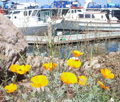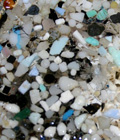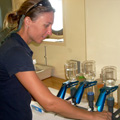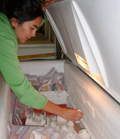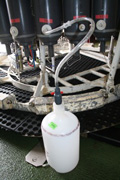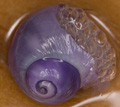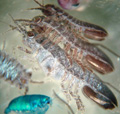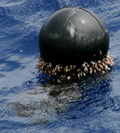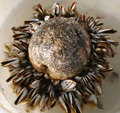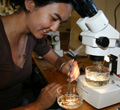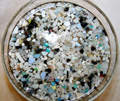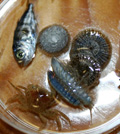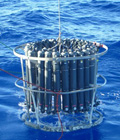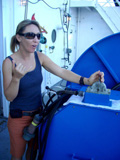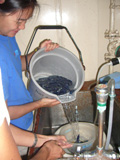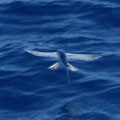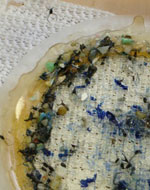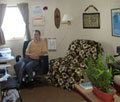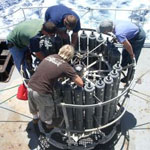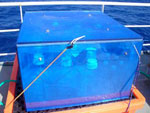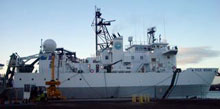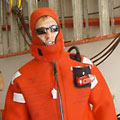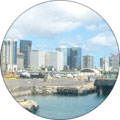- C-MORE Home
- What is Microbial Oceanography?
- What is C-MORE?
- Research
- • Research Cruises
- » Survey of Underwater Plastic and Ecosystem Response (SUPER)
- SUPER Home
- Lucy Marcus' Blog
- The Science Plan
- Cruise Report
- Science Personnel
- SUPER HI-CAT Wikipedia Article
- SUPER HI-CAT Data Links
- Education & Outreach
- People
- Publications
- Image Library
- Contact Us
Lucy Marcus’ SUPER Cruise Blog
Calendar of Entries | ||||||
| S | M | T | W | T | F | S |
| A U G U S T | 21 | 22 | 23 | |||
| 24 | 25 | 26 | 27 | 28 | 29 | 30 |
| 31 | 01 | 02 | 03 | 04 | 05 | 06 |
| 07 | 08 | S E P T E M B E R | ||||
 Lucy Marcus, a documentary filmmaker and marine biologist, joined the C-MORE SUPER Cruise to communicate about the effects of particulate plastic accumulations in the North Pacific gyre on microbial oceanography. Lucy has provided photo/video documentation of the cruise, blogging about the activities at sea, and assisting with sample collection and processing. The blog, photos and video aim to provide students and the public with meaningful, scientific, and occasionally entertaining commentary about the materials, methods, and basic results of the 12-day cruise, as well as an introduction to daily ship life and the personnel involved with the cruise.
Lucy Marcus, a documentary filmmaker and marine biologist, joined the C-MORE SUPER Cruise to communicate about the effects of particulate plastic accumulations in the North Pacific gyre on microbial oceanography. Lucy has provided photo/video documentation of the cruise, blogging about the activities at sea, and assisting with sample collection and processing. The blog, photos and video aim to provide students and the public with meaningful, scientific, and occasionally entertaining commentary about the materials, methods, and basic results of the 12-day cruise, as well as an introduction to daily ship life and the personnel involved with the cruise.
Lucy has previous experience creating ship logs and videos about research projects. Lucy’s film about her masters’ research on cleaner shrimp played at the San Francisco Ocean Film Festival this year. SUPER won’t be Lucy’s first interaction with trash in the oceans; while in the Northwestern Hawaiian Islands, she removed marine debris and drift nets from coral reefs in monk seal habitat. Lucy loves being part of marine research teams and aims to create many documentaries about ocean issues to inspire the public to protect marine environments around the world.
This page is Lucy’s blog about her experiences at sea; you can email her your questions and comments. Mahalo!
Note: Click on all of the images below to see the full size version. All photos are by Lucy Marcus unless otherwise noted.
Friday, September 5 • Port Hueneme, California
Great Success!
|
Our exciting journey has come to an end. We have tied up to the dock near Los Angeles, California with the feeling that the trip was a great success; here's why: -We completed all of the work that we planned to do I want to thank you for following along and reading my blog entries. I have learned so much on this trip and hope you learned some exciting information about microbial oceanography and marine debris from the blog as well. I was not able to write about all the different parts of the research that were going on, however, more of these will be included in the 5 minute movie that I will be creating about this cruise. I aim to have this movie completed by late October. If you are interested in viewing this movie, please contact Kimberley Weersing. Keep On LearningI hope you continue to learn more about plastics and their effects on the environment as well as the importance of microbial oceanography for our planet. There are many sources for information, so please check with your local library, Internet search engines, universities, and non-profits for more information. One of my favorite books that I have read recently was "The World Without Us" by Alan Weisman. The chapter titled "Polymers are forever" is about the garbage in the Pacific and the research that Charles Moore and the Algalita Marine Research Foundation have been doing for 10 years about the effects of the plastic on the environment. I also recently found out about Styrophobia, a Hawaii based company that markets biodegradable and compostable disposable products, such as take-out containers and utensils. Styrophobia employee Ari Patz was a valuable team member on this cruise, helping with data collection and sharing valuable information about sustainability. You can help by being aware of what you purchase, making sure things you buy can be recycled, but first refuse things that you may not really need and reuse whatever you can. Bring your own cloth bags to the store, or your own cup to the coffee shop, or refill your glass or metal water bottle. Sit down and eat at a restaurant so the dishes can be washed instead of taking your food in to-go in containers. Encourage every restaurant you eat at to use biodegradable take-out containers. Participate in beach, ocean and river cleanups, and pick up plastic trash that you may see in everyday life. Join list-serves and non-profit organizations that encourage protection of the marine environment, or participate in community events, bring your friends and family and make it fun. This planet we live on is an incredible place with diverse interconnected systems working on a vast scale. But remember that the actions that each of us chooses to take, may have effects on the planet for years to come. Choose wisely! Thanks again for reading. Signing out: Lucy Marcus |
Wednesday, September 3 • Lat: 34°37.713'N Long: 122°49.322'W
Poem of the Day
|
Where are we? It's amazing you know It spirals around It could become a home We venture to the wide blue expanse We might find out Think about what you buy The seas have become rough Each test tube, each sample Dissolved nutrients |
|
|
The fruits and vegetables and grains you ate today, all depended on nutrients from the soil and water to grow strong and healthy. Just like land plants, marine microbes also depend on nutrients in order to grow and thrive. Dissolved nutrients are the nutrients available in seawater for microbes to use for growth. The nutrients the scientists are investigating in the Pacific are carbon, phosphate, nitrate, nitrite, and silica. These nutrients are dissolved in seawater when the particulate matter, bodies or waste of organisms degrade. The scientists take samples of seawater from various depths and freeze them in small bottles, to later defrost and analyze for all the dissolved nutrients. These tests will reveal the levels of nutrients available to the microbes, to see if the water surrounding the microbes contains enough nutrients for efficient growth. It is typical for water in lower depths to have more dissolved nutrients, because phytoplankton and zooplankton fall to the ocean's depths where they are consumed by other organisms and eventually released as dissolved nutrients. This deep water is considered nutrient-rich. Shallower water has less dissolved nutrients because nutrients are taken up by the photosynthetic microbes living near the surface in the sunlight. When deep water mixes with the shallow water, the nutrients from the deep water act as "fertilizer" and cause the life near the surface to flourish, sometimes forming blooms of microbes at the base of the ocean food web. ATP (Adenosine Triphosphate) TestsAdenosine triphosphate is the molecule that every cell uses as power, from the cells in your body to the cells in marine microbes. Because ATP breaks down quickly after a cell dies, this analysis shows how much of the total carbon found on the filters was due to living phytoplankton and microbes rather than dead plankton or fecal matter. By understanding how much living phytoplankton was in the sample, the scientists can extrapolate, or make estimates of how much phytoplankton was in the general region. To isolate the ATP from a sample, scientists first filter one liter of water through a glass fiber filter. This filter is inserted into a glass vial and the ATP gets extracted in a boiling buffer. The test tube and buffer are cooled and refrigerated. Back at the lab at the University of Hawaii, the scientists can measure the amount of ATP from the sample. They do this by adding a luciferase enzyme to the sample (luciferase is the chemical that makes fireflies glow), and measure the amount of light emitted. The amount of light emitted corresponds to the level of ATP in the sample; brighter light means more living organisms in the sample. Through these tests, scientists may be able to determine if the densities of microbes are different in ocean areas with high plastic concentrations, than in the areas that have fewer plastic pieces. [ Top of Page ] |
Tuesday, September 2 • Lat: 35°7.719'N Long: 128°5.540'W
What's Going On?
|
We have used up all of the allotted 72 hours of science time, which we spent doing a total of 14 CTD casts and manta trawl tows, so now we are transiting straight to California; no stopping for science! We are more than half way across the Pacific now, and will be going full steam (11 knots), all the way to Port Hueneme just north of Los Angeles. We still have a lot to do, like packing away equipment and cleaning the labs. Some of the scientists are still processing and organizing their collections of plastic, filters, and water samples, so they are easy to keep track of back in the labs at the University of Hawaii. The crew of the Kilo Moana is still doing lots of maintenance, removing rust, painting and preparing the ship for a marine biology cruise that starts as soon as the ship reaches California. Today was Jeff Ernst's birthday, so the chef made him a great chocolate cake, and some of the science crew had a fun night in the lounge watching movies and eating popcorn. Measuring Particulate Carbon, Nitrogen, Phosphorus, and Silica.All living things are made of a few basic elements that are the building blocks of life! Something that humans and plankton have in common is that we are all carbon rich, and phosphorus poor. One of the experiments on this cruise measures the total particulate matter in the water. This allows the scientists to compare ratios of carbon to nitrogen to phosphorus to see how phytoplankton are growing, and if their growth is limited by the low availability of one or more nutrients, or if they are growing at maximum efficiency. The scientists prepare the equipment used to measure particles in the water. 1) First they must collect the water from various depths using the niskin bottles surrounding the CTD. 2) The water is drained from the collection bottles into 2-4 liter bottles through a primary filter that removes the zooplankton (plankton that eat other plankton). Because they are focusing on microbial life, the zooplankton are removed as they are larger than microbes, and are not primary producers. 3) The water will be filtered a second time through the particle-catching filters, which remove all the phytoplankton and other matter from the water, which the scientists want to investigate. The filter holders are fitted with quarter-sized glass-fiber filters that have been combusted at 500 degrees C for 5 hours, a process which removes phosphorus and additional carbon. Some of the glass filters are also washed in acid, to remove more phosphorus and anything else that might alter the tests. Each analysis for each different nutrient gets a different filter, and to measure the silica content in the water, a polycarbonate filter is used, because a glass filter is made of silica and would ruin the test. 4) The 2-4 liter bottles containing the water samples are inverted into racks and the water flows through a series of tubes and through the various filters. The filters are removed with forceps, put into small cases and frozen for later analysis in the lab at the University of Hawaii. The analysis will give the scientists a bulk measurement of all of the particles in the water, living and dead. [ Top of Page ] |
Monday, September 1 • Lat: 35°25.080'N Long: 134°12.783'W
Final Countdown
|
Today was the last day we trawled for plastic, took deep water samples, and used the CTD. From now on, we will only be taking water samples from the shipboard seawater system while we are underway to California. During our two manta trawls today, we caught fewer pieces of plastic than we caught in the trawls in the preceding days. Today the trawls had only about 200 pieces of rice-sized plastic pieces, and only a few days ago we were finding over 1000! Yesterday, we encountered a swell that has caused the ocean surface to become choppier, which might explain why we got fewer samples. More turbulence causes more mixing; so plastic particles don't get a chance to accumulate on the surface. We also caught fewer animals today, but as usual we always bring up something interesting. This morning, we found a jumble of rope in the trawl, with little pieces of plastic imbedded in it, and we found the typical various sized pieces of plastic, the majority of them about rice-sized. While the trawls were in the water, we counted pieces of plastic floating by the ship and we continued to see about a piece every minute. We saw things like a 4ft by 3ft plastic mat, a 2ft long crate, a 1ft diameter fishing float, and little bottle caps. The Kilo Moana AquariumWhen we tow the manta trawl, we are aiming to catch plastic, but unfortunately, we often inadvertently catch marine organisms. We record the species and number of most animals, photograph them, look at them under the microscope and return as many to the sea as possible. In this afternoon's trawl, there were two juvenile flying fish, sea buttons (Porpita porpita), lots of marine water-striders (Halobates), blue copepods, and silver isopods. Some of the crabs were so small and young that they were almost transparent! There were also beautiful purple snails, called Janthina, which float on the sea surface by exuding a tiny raft of bubbles. We could see tiny pink dots on the bottom of our glass collecting dishes, and when we put the dishes under the microscopes, we could see that these pink dots were actually tiny snails, with five little tentacle-like extensions coming out of their shells. So beautiful! We have caught a few pieces of plastic with anemones on them and we watched them eat copepods or Halobates that happened to get stuck to their tentacles. My favorite animals to look at were the squid we caught yesterday. One was relatively large, about an inch long, with a rainbow iridescent sheen on its clear body, mottled with brown spots. Its eyes were huge, and through the microscope, you could see the suction cups on its arms. Angel has a great contraption that attaches to her camera and fits to the eyepiece of the microscope. We have been enjoying taking photos of the tiny creatures under the scope. Jeff also has a really great macro lens for his camera, which zooms in about as much as the microscope! After doing a great job posing models, we tipped the sea creatures back over the deck of the ship, and wished them a safe journey. [ Top of Page ] |
Sunday, August 31 • Lat: 35°17.356'N Long: 143°0.922'W
The Horse Latitudes
When was the last time you were at a raucous celebration where an effigy of something was paraded, destroyed or burned to celebrate freedom or progress? I'm sure one of these celebrations must be happening somewhere on the planet today! Sometimes these ceremonies become so intertwined with history, that national holidays or even geographic features are named after them, like the Horse Latitudes. We are making our way East, towards California, closely following the 35 degree north latitude line. This latitude marks the northern boundary of the Horse Latitudes, a subtropical region between 30 and 35 degrees north and south of the Equator. Under the subtropical ridge, the Horse Latitudes receive little rain and variable winds mixed with calm, and sailing ships can get stuck with no wind in these calm regions. It is partially because of these calm conditions that we come here to find the trash accumulations. Similar calm, dry conditions are found between 30-35 degrees South of the Equator too. Within these two latitudinal bands, we find the largest deserts, such as those in the Southwestern United States, Northern Mexico, the Middle East, the Atacama, Kalahari and Australian deserts. Solar heating at the equator causes the air to rise, which creates another calm region where sailing ships can be doomed with no wind. The air that heats and rises at the equator travels to the North and South and subsides again at the Horse Latitudes. So why, you might wonder, is this region called the Horse Latitudes? Some people speculate it is because doomed sailors on wallowing sailing ships that were stuck in the calm area would throw their horses overboard to conserve water or lighten the load so the ship would move. Many sources say that probably would not have happened, as horses would have made great meals and sailors were usually limited to eating salted dried meat. There is another story about the origin of the name, which stems from the "Dead Horse" ceremony where sailors would parade a straw-stuffed effigy of a horse around the decks and throw it overboard. Because seamen were partially paid in advance before leaving for a long journey and often spent their money in port, the first month or two at sea felt like they were working for free. The officers would say that the difficulty in getting the crew to work during the first months of a voyage was like beating a dead horse. These first months at sea the seamen would be working off their 'dead horse' debt. The end of this period, celebrated with the dead horse parade, would often occur when westbound ships from Europe were crossing the subtropical region between 30-35 degrees North of the Equator. The name most likely stuck, as the celebration was associated with the region. Today, people in the Navy still refer to 'dead horse' pay, when crew members get paid before going to sea. Tiny Balls of Life | ||||
|
Yesterday I discussed the Styrofoam float we found covered in life: barnacles, crabs, and many marine microbes that we couldn't even see. Some people might see these floating objects as trash, but some organisms might see them as a vital habitat, something to cling to in a region where there normally is no hard substrate. Imagine a smaller scale where instead of a float with big barnacles, we find a tiny ball of life encrusted with a thriving microbial community. The plastic substrate in the ocean can have many times the number of microbes as ambinent seawater. Alli Fong is investigating the microbial life that may have found new habitats by attaching to the tiny pieces of plastic adrift in the Pacific. She is collecting and preserving pieces of plastic to investigate the bacterial and other microbial communities growing on them. She will be sequencing the DNA of the plastic-associated organisms to look for gene markers so she can determine what species are taking advantage of this habitat. Alli and other scientists on board will also be looking for other genes to find out if the microbes are photosynthesizing, and thus providing both food and oxygen to the ecosystem. Imagine how big the Pacific is, and how many billions of pieces of plastic could be out there. Microbes are living on these plastic pieces may actually a noticeable effect on nutrient cycling processes in the ocean. That is one of the things we hope to start understanding from the research on this trip: do the microbes growing on the plastic have an effect on productivity and chemical cycling? We might think "why would these microbes matter, they are so small," but the oceans are huge, and full of microbes which actually make up 98% of the marine biomass. That's amazing: if you gathered everything living in the ocean, whales included, the microbes make up almost all of the life. We are lucky to have so many marine microbes on the planet, because they produce half of the oxygen in our atmosphere. Other marine microbes help stabilize the climate by transforming atmospheric CO2 into cellular material, which is another reason we can appreciate marine microbes. However, if there are many more microbes living in an area like the Pacific garbage patch, because there is more substrate for them to grow on, changes could occur in patterns that have existed for a very long time. On this trip we hope to gain a better understanding of the effects marine plastic might have on the microbes and their important functions. [ Top of Page ] |
|
|||
Saturday, August 30 • Lat: 35°2.063'N Long: 146°48.632'W
The Ball of Life
|
Today we pulled in the manta trawl to find the mouth of the collection sock plugged with a large object. When we dumped it out, we realized it was a Styrofoam fishing float covered in gooseneck barnacles and crawling with crabs. Those were the living things we could see, but the ball was probably also home to numerous tiny microbes that had found substrate to attach to in this vast ocean where there normally was nothing solid. A debate ensued on what to do with this 'ball of life'; should we toss it back into the ocean, so the life on it could continue to live? Or should we dispose of the float because it really was trash, with bits of foam flaking off? However, this float could take hundreds of years to degrade in the ocean. If we removed the barnacles, crabs and microbes from the float and then properly disposed of it, the animals would probably die because they needed to be attached to a floating object to avoid sinking. What would be the right thing to do with large debris that had become a small ecosystem, and home to many animals and fish? Was it trash, or was it habitat? What do you think you would do if you had to decide? On a smaller scale, are the tiny pieces of plastic we find in the trawls 'trash' or habitat for marine microbes? We decided it was best to remove all the barnacles and crabs from the float, return them to the ocean (as they will decompose and become part of the nutrient cycle), and incinerate the float in the ship's complete combustion trash incinerating system. R.I.P. ball of life! Tomorrow I will get into more detail on how the scientists are looking for life on the small plastic particles we find, which may have become new microhabitats in a region where there previously was nothing for microbes to attach to. Record Plastic Count!Barb and Kim are the new record holders for counting 2-5mm 'rice-sized' pieces of plastic: they counted 1050 in one trawl! There were also over 200 pieces of small 0.2mm 'sand-size' plastic and 50 pieces of larger plastic, and the 'ball of life' in the same trawl. It takes hours to count all these pieces and put them in the vials for various tests, but we entertain ourselves with tunes from the portable speakers, and take breaks to look at the funny creatures under the microscopes. Follow the Path of the Kilo MoanaIf you are interested in seeing the path of the ship across the Pacific, you can check the ship's website where the progress of our journey is plotted on the map every 6 hours. http://imina.soest.Hawaii.edu/UMC/amarcen.htm Choose> 'R/V Kilo Moana', 'Current Location' Water Sampling from the Mixing ExperimentOn August 26th, I wrote about the Mixing Experiment where 'deep' seawater was mixed with water that was collected at the surface, then left to incubate in containers in the sun for the duration of the journey. This experiment represents nutrient cycling where upwelling of deep nutrient rich water rises to the surface to 'fertilize' the phytoplankton growing there. Three containers of incubated mixed water are filtered each 48 hours of the cruise. So this means that in some of the containers the phytoplankton only have a couple days to 'grow' while in other containers, the phytoplankton are allowed to grow for many days. Jay and Tara filtered the water from a few incubated containers of mixed water to measure chlorophyll concentrations. This helps them calculate of how quickly the phytoplankton are growing and using the nutrients from the deep water. In order to filter, the scientists allow the water to flow from inverted containers through tubes with filters attached. The filters are white round disks, about the size of a quarter, made of combusted glass fibers. After filtering 4 liters of water, Tara opened the filter case and the filter, which started as pure white, had a bright yellowish green layer on it. The photosynthetic phytoplankton living and growing within the mixed incubation container were strained out of the water onto the filter. This experiment aims to help us understand the nutrient cycling processes, phytoplankton growth rates and uptake of nutrients over various lengths of time. Albatross FlybyToday I saw my first black-footed albatrosses of the trip, so big and beautiful! The dark grey birds had massive wingspans and huge curving beaks and glided gracefully close to the swells, riding the updrafts off the waves. There were at least three around at the same time, and they rested on the water behind the ship, one looking as if it was eating something. During the same time, Barbara and I watched plastic float by the ship at a rate of about one piece every 3 minutes as the ship was going 4 miles per hour. I saw a big white bucket, an orange crate, a jumble of rope, and a mesh cone, along with lots of other small pieces. When we collected our manta trawl, we found a lighter from Hong Kong in the net. It is an unfortunate fact that albatrosses collect small pieces of plastic, including lighters, perhaps thinking they are fish, and feed them to their chicks. The chicks sometimes perish from malnutrition, because their guts are full of plastic. I hope the albatrosses we saw today were able to find something a little more tasty than plastic to eat. If they had waited a bit, they could have had some fresh gooseneck barnacles and crabs that we tossed back to the sea from the late 'ball of life.' [ Top of Page ] |
Friday, August 29 • Lat: 34°42.544'N Long: 150°9.669'W
Plastic Update
|
Today we all have been very busy counting hundreds of pieces of plastic, and taking lots of water samples with the rosette of niskin bottles surrounding the CTD (a rig holding instruments measuring conductivity, temperature and depth). Barbara Mayer, our teacher at sea, won the prize today, counting over 700 pieces of 'rice-sized' plastic from one trawl! From the same trawl, Kim Weersing and I counted 300 'sand-grain-sized' pieces until our eyes were going blurry. We caught a white bottle in the trawl today that was covered in bryozoans in tan honeycomb patterns. We poured a pair of crabs out of the bottle too. I loved seeing the life that came up in the net, under the microscope in the lab: a striped fish, squids, crabs, isopods, blue sea buttons (Porpita porpita) which are pelagic hydroid colonies, and even a tiny anemone in a bottle cap. We poured the plankton that we caught in the trawl back overboard after sunset, and the copepods were glowing with bioluminescence like little fireflies, so pretty\85 be free!! A few of us have been counting plastic floating by during the trawls and have found an average rate of one piece of plastic passing by every minute, when the ship is going about 4 miles per hour. Some of the items looked like a bucket, bottle caps, rope, and flat shapes of plastic often a few inches long. Water Sampling Experiments:Over the past couple days, we have been doing 3 manta trawls and 3 water sampling sessions each day, because we are in the region where plastic particles concentrate and the weather is calm. To collect the water, the winch operator lowers the CTD rig into the deep ocean. The rig has CTD instruments strapped to the inside of a circle of niskin water collection bottles. The caps to the long water collection bottles are pulled open before the device is launched, and each tube is triggered to shut when the device reaches a certain depth. Once the CTD rosette is winched back on board, the scientists begin draining the water from the collection tubes, for their experiments. Before we left for the trip the scientists suggested we bring rubber boots for the water collection, and now I understand why: water from the tubes shoots out all over the place, pools on the wet-lab floor, and gets dumped out of containers when they are being rinsed. I have no boots; my running shoes are wet, but it's a fine sacrifice for science! There are so many water sampling experiments conducted on this ship, so I will explain one each day, so you can get your feet wet too. Oxygen and Productivity:We all know that plants on the land photosynthesize and produce the oxygen that we breathe, but did you know they only produce %50 of the oxygen on the planet? The other half of the oxygen is produced by phytoplankton, tiny single-celled plants of the sea! Donn Viviani, a UH grad student, is studying the biomass of photosynthetic phytoplankton and bacteria, as well as respiration and productivity of the ocean. By adding calculated amounts of manganese chloride and alkaline iodide to flasks of seawater from certain depths, Donn can later deduct how much oxygen was in the seawater from that depth. Oxygen gets into the seawater through contact with the air, and is also produced by phytoplankton and bacteria. This oxygen in the seawater is used by many organisms living in the sea, like fish, which filter oxygen through their gills. There is less oxygen in the dark depths of the oceans because there are no phytoplankton to produce oxygen (because they need sunlight in order to live) and because non-photosynthetic cells consume oxygen when they feed on other cells. Understanding oxygen levels in the water will help Donn and other scientists know how productive the water is in certain regions. Chlorophyll is the basic pigment of plant matter, and it is measured indirectly using a sensor on the CTD that measures fluorescence. Measuring how much chlorophyll is in the water tells us about the amount of photosynthetic biomass, i.e., how much phytoplankton and photosynthetic bacteria are present. The florescence sensor however, needs to be calibrated or adjusted to match true chlorophyll levels in the water. To do this, Donn tests the chlorophyll levels in water samples from various depths and adjusts the sensor accordingly. These measurements can also be converted to carbon, and will show how much carbon a region of the ocean is holding. The oceans are important carbon sinks; they cycle atmospheric carbon, which has important implications in climate stabilization. More fun in store for us tomorrow; water sampling and manta trawls start at 6 am. California here we come! [ Top of Page ] |
Thursday, August 28 • Lat: 32°00.1870 Long: 153°00.2402
Plastic Fantastic!
|
Today we did two more Manta Trawls to search for plastic particles in the vast Pacific. Jackpot! Lots of plastic again! We came up with about twice as much plastic today, compared to yesterday’s trawl, still only a couple of handfuls at most, but today we caught much larger pieces. A few of these large pieces were 3-4 inches long, but we also got a colorful array of thumbnail to sand grain size pieces again. In today’s trawls, the particles in the smallest size class were bigger, so they were a bit easier to pick out with tweezers to insert into the sample vials. My favorite part of today was getting to operate the winch that let the Manta Trawl out and back in to the ship. I love machinery! We set the Manta Trawl out for 1.5 hours, two times today, and pulled it up to empty the contents of the collection ‘sock’ into a bucket. We separated the plastic and marine life into different size classes by pouring the bucket of seawater and particles through mesh screens of decreasing sizes. We end up with three dishes of plastic particles, each containing a specific size range: larger than 5mm (thumb nail size, and including the 3-4 inch pieces), between 2-5mm (pea size), and greater than 0.2mm (tiny sand grain size). In the lab, we place the plastic pieces into various vials, with detailed labels, so we can later analyze DNA, RNA, chlorophyll and ATP of the microbes on the plastic. Quite a few interesting objects and creatures came up in the trawl today. One of the bigger pieces we caught was a bottle cap, and it had two tiny crabs living inside of it. Jeff, who has done plastic trawls before, said nearly every bottle cap caught in a trawl has crabs living inside of it! We also caught two excitable little triggerfish, one about 1 1/2 inches long, the other half the size. "Be free!" I told the crabs and fish while I tipped them over the side of the boat. In every trawl, the net comes up packed with at least 25 blue jellyfish called by-the-wind sailors. Angel and Barbara looked through microscopes and found that about 5 out of 100 by-the-wind-sailors (Valella valella) had plastic particles in their feeding polyps. We also used the microscopes to look at an interesting isopod, a silvery insect like creature with many legs, that we caught in the trawl. Watching trash float byIn the afternoon, Jeff, Ari and I went to the top deck by the wheelhouse, and watched for large plastic pieces floating by while the boat was slowly dragging the Manta Trawl at 4 miles per hour. We saw 22 pieces of trash pass by in 45 minutes, and snapped close up photos of them with long camera lenses. Some of this trash was very large, like a 2-foot long crate, or a 3-foot long plastic cylinder, but the most notable piece of junk was a 1-ft bright orange piece of foam, bobbing on top of the waves. We would have loved to remove this trash from the sea, but with the trawl underway, and limited ability to grab the items; we had to just take note of them. It was interesting to be up on the deck, looking at the wide blue ocean, which appeared to be clean as could be at first glance, but when we saw a piece of trash float by about every two minutes, we realized that the sea was not as clean and clear as it first appeared. Why are we doing this?The SUPER Cruise scientists are investigating the microbial communities associated with and growing on the plastic. They will look for specific gene markers to determine the diversity of the microbial organisms. The scientists can also look for other genes that will help to determine if the organisms are photosynthetic. The scientists also hope to determine whether there are genes present in these microbes that would give them the ability to decompose hydrocarbons, like the hydrocarbons in plastic. The SUPER Cruise investigators can search for genes similar to the ones found in hydrocarbon-decomposing bacteria in other environments, i.e. during oil spill remediation or waste management. If such genes are present in the plastic-associated marine bacteria, the scientists can then test to see if the genes are ‘on’ and working. Very exciting! Tomorrow I will discuss the other research projects we are doing on this cruise and the operations involved. The scientists are investigating ocean productivity and chemical cycling in this region of the Pacific. These experiments will help the scientists learn more about the biomass of microbes in the ocean, and the role the microbes my play in maintaining the climate. But remember, this is the very first trip ever to study the microbial communities on oceanic plastics. We may not find definitive answers during this cruise, but we will find information that will point us in the right direction for future research. [ Top of Page ] |
Wednesday, August 27
Are We There Yet?
|
When I first was invited to go on this cruise, I thought the ship would be cleaving through mounds of plastic and garbage, like an icebreaker busting through the ice. Well, it’s not like that at all. The seas here look clear and deep blue, and there’s barely anything in sight, but wait… what’s that? Is that a bird? Oh, it’s a flying fish gliding above the surface of the water! There’s not much life to see above the waves, other than bird-like schools of flying fish, but I did see a wedgetailed shearwater today. It’s amazing to see a seabird like this over 350 miles from land. We are slowly approaching the high-pressure zone in the north Pacific; it shifts on a daily basis, and may move drastically throughout the seasons of the year. This ‘high’ is where the seas are calm and is typically where floating objects accumulate. But remember: the ‘high’ moves, and so does the trash. We also are within a longitudinal region of the Pacific called the Horse Lattitudes, 30-35 degrees North of the Equator, which typically has calm winds. It is an area where unlucky sailing ships, long ago, might have wallowed with their sails hanging limp, and sailors risked perishing if the winds failed to return before supplies of food and water ran out. Arrrg, matey! Well luckily that won’t happen to us; the cooks are amazing and we seem to have no end to supplies of fresh fruit and the salad bar, so no scurvy sea dogs here! Plus, the saltwater desalinators make tasty drinking water all day long. I can’t see our 100,000 gallons of fuel running out any time soon either! But if it were wind we needed to get around, we would be in trouble, because the seas are calm and the breeze so light. We seem to have come at least to the edge of the “patch” of garbage, if there really is a patch, but it seems just as likely that the plastic particles are distributed throughout a vast area of the Pacific, floating just below the surface. I did however; see a few foot-long pieces drift by today at the rate of about one piece every 5 minutes. We’ll see how things change as we venture further! Trawling for PlasticToday we did the first Manta Trawl. No, we were not hunting for manta rays; we were actually hunting for plastic! The Manta Trawl really looks a bit like a manta ray. Its metal, mouth-like front panel glides at the surface of the water. Behind this “mouth,” plastic particles and small marine organisms are funneled into a long mesh net and the water flows out. The Algalita Marine Research Foundation is loaning us the trawling device that we are using on this transit. Researchers from the Algalita Foundation have been studying garbage in the Pacific for over 10 years, often using this very device to sieve plastic from the water. We towed the Manta Trawl behind the ship for 1.5 hours, two times today, as we progressed along our northeasterly route. After the crew winched the Manta Trawl back aboard, Jeff Ernst washed everything that collected in the removable “sock” at the end, into a bucket. Eureka! We hit the jackpot! We were all excited (and of course dismayed at the same time) to see the handful of various shapes and sizes of plastics in blue, white, black and pink interspersed with piles of blue clear jellyfish called by-the-wind sailors (Valella valella). Some plastic pieces looked like jumbled fishing line, but it was nearly impossible to tell what the other tiny plastic chips were. Some of these pieces were the size of a finger nail, but some were so tiny, we had to squint to pinch them with our tweezers; they were the size of a grain of sand! We counted hundreds of them in a saucer-sized dish. We also found that the trawl caught quite a lot of marine life including marine insects similar to water striders (Halobates spp.), tiny fish less than 1/2 and inch long, miniature gooseneck barnacles growing on the plastic, and some little crabs, which Kim set free! For the next few days, we will be very close to the center of the high pressure zone, so we will trawl for plastic three times a day, and observe and record plastic passing by on the surface. We are approaching the thick of it! Tomorrow I will discuss more about what we are doing with the plastic we collect, and what we hope to learn. Volunteers needed to dismantle the Junk Raft!JUNK, the boat made out of 15,000 plastic bottles and an airplane fuselage has arrived safely to Ala Wai boat harbor after 3 months of sailing across the Pacific from California. The crew and friends will be breaking down the boat on Thursday, August 28, and would love as many hands as are able, starting at 10:00 and throughout the day. At 5:00, the wonderful people at the fuel dock will be grilling up burgers, making salads, and providing refreshments — so come by any time to pitch in. The boat will be reassembled for a temporary display at the Waikiki Aquarium. Please contact Anna Cummins of the Algalita Foundation for more information: 310-998-8616. [ Top of Page ] |
Tuesday, Aug. 26 • Lat: 24°42.9086 Long: 156°08.6474
Always Something New
|
Never a dull moment on the SUPER Cruise: today I watched the first winch-assisted water collecting operations, toured the high tech wheel house, had a great chat with the captain in his plant-filled lounge, and ventured into the computer lab, which is equipped with floor to ceiling computer monitors. Where am I?Outside my window the sun shines through sparse clouds on the sapphire blue ocean; wow, a school of flying fish just took flight! The water is 11,800 feet deep in this area of the Pacific, 225 miles northeast of Honolulu. We still have 215 miles to go until we get to the first zone of plastic sampling, so we keep our heading of 21 degrees and 15 miles per hour (11 knots) maintained by the auto pilot controls in the wheel house. Too easy! Mixing Experiment:The ship stopped for about an hour today, just long enough for the science crew to deploy the CTD, a circular rig of water collection cylinders measuring conductivity, temperature and depth. This 5 ft tall rig was lowered into the water by a crane-like winch, through a carefully orchestrated operation involving scientists and ship crew wearing orange life vests and hard hats. The cylindrical bottles were cocked open at the surface and were triggered to close at 350 meters (over 1000 ft)! Once the CTD was winched back to the surface, the deep water was “milked” from the cylinders into plastic containers. The “deep” water was mixed with water that was collected at the surface, through the ship’s saltwater faucets. Tara Clemente, the lead scientist, explained that the water from the surface usually has a higher concentration of particles comprised of organisms, like phytoplankton (tiny plant-like floating organisms that make their own food), which depend on sunlight for growth. The “deep“ water contains more dissolved nutrients, which occur when particles like plankton sink, and decompose into carbon, nitrogen, and phosphorus. The nutrient rich water from the deep can encourage growth of phytoplankton, so the mixed water containers are put into “incubators” on the deck of the boat so they can be in the sun. The incubators are large clear water tanks covered in plastic blue panels to mimic the light levels near the surface of the ocean. Three of the incubated containers of mixed water are opened every 48 hours to measure concentrations of nutrients, to determine if the plankton from the surface water might be using up the nutrients from the added deep water. Why are we doing this?This experiment creates similar patterns to ocean upwelling, where currents or storms bring nutrient rich deep water to the surface, which nourish phytoplankton. Phytoplankton are the base of the marine food web, and in the future, climate change may increase or decrease the typical cycling of nutrients in the ocean, and change the delicate balance of the food web and carbon cycling. This experiment aims to help us understand the nutrient cycling processes, phytoplankton growth rates and uptake of nutrients over time. I am learning how important these tiny creatures are to the entire scheme of things on the planet. Phytoplankton provide food for almost everything that lives in the oceans, from zooplankton (plankton that eat other plankton) to whales and sharks, through links in the food web. Phytoplankton may also hold answers to some of our most pressing questions about climate change and the movement of carbon through the atmosphere and ocean. Research trips such as this one, may help us understand more about the changes occurring on the planet, so stay tuned, science is so cool! The Junk RaftOn Wednesday, August 27th at 10am, a sailing raft made entirely of recycled material plastic bottles and a plane fuselage, is due to arrive at the Ali Wai fuel dock in Honolulu. This boat and its two crew members spent the past couple of months crossing the Pacific, in the opposite direction of our journey, and last night at 8pm we passed them, our mate exchanging some words with them over the radio. Their mission is to spread awareness about the Great Pacific Garbage Patch, so welcome them to shore if you are in Oahu, and check out their website at: Junkraft.blogspot.com. (Please note that the views expressed in the junkraft blog may not be representative of the views of C-MORE.) [ Top of Page ] |
Monday, Aug. 25 • Honolulu, Hawai'i
The Maze
|
Worried that I might get lost, I memorized landmarks in the hallways of the 200ft long Kilo Moana research ship. To get to my room I turn left at the giant red fire axe, go down the hall from the 3D map of Hawaii‘s underwater topography, and pass the gym! I spent the night on the ship last night, comfortable in my top bunk, and happy that the ship was still in the calm harbor. My room is spacious, has a big widow (with an ocean view), sink, drawers and lockers, desk, even a flat screen TV that plays movies, and connects to the captain’s navigational equipment. This morning, the rest of the 10 scientists arrived at sunrise, most running on adrenaline after a marathon night of packing. We had eggs and bacon or oatmeal and fruit in the galley then a meeting with the captain, and a fire drill. We all laughed as Ari Patz (right) practiced rushing into his safety suit, a giant red insulating outfit that protects you from the cold water if you have to abandon ship. The ship moved to the fuel dock and the 20 ship crew members spent four hours pumping on 100,000 gallons of Diesel fuel. The ship uses about 3,300 gallons a day when at full speed, and only 1,500 a day when relatively stationary and doing operations. Imagine how much that costs when fuel is $4 a gallon! In a conversation with one of the engineers, I found out that very soon, strict regulations will be going into effect making all new vessels install engines that will be up to 90% more efficient, and old ships will eventually have to upgrade as well. Some ships are even using huge kites, like those used by kiteboarders, to pull the boat so it uses less fuel, very cool! We set off into the Pacific around dinnertime, watching sunset over Diamond Head after a big dinner of Mahi Mahi and birthday cake (one of the engineers’ birthday). We are motoring North, to an area when the shifting high pressure zone creates calm waters and the trash we seek, is known to accumulate. The view out my window is now black night, the ship is rolling, waves slam on the hull… maybe its time for some ginger tea. Now which way was it to the galley? Pass the fire axe… right at the gym… [ Top of Page ] |


